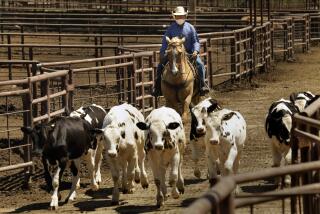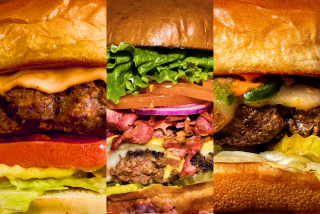A Great Burger? Here Are the Secrets
- Share via
Meat is the critical part of any hamburger, of course. But after cooking dozens of hamburgers, the Test Kitchen made a few surprising discoveries.
The first was, don’t start with hamburger.
The best patties, by far, were the result of quickly chopping chunks of steak in a food processor. Coarsely chopped beef has a light, fluffy texture, not packed down and dense like packaged ground beef. We combined 1 1/2 pounds of a lean steak, such as a strip, with 1/2 pound of a fattier rib-eye. The fattier beef makes for a better, juicier burger. If you want a truly amazing burger, try dry-aged beef, available at stores such as Gelson’s and Bristol Farms, as well as specialty butchers. The flavor is intensely beefy and rich.
Keep the meat cold in the refrigerator until chopping time. You’ll get a cleaner chop and the fat won’t get pasty. Cut the meat into 1-inch cubes and remove any gristle. It’s OK if a small amount of fat remains, since fat adds flavor.
Add the meat to the processor in batches and pulse 10 to 15 times. Pulsing--the quick starting and stopping of the processor--doesn’t over-process the meat, which can result in a tough burger. When the meat is correctly processed, it should look almost light and fluffy, but with a coarse, chopped look. There will be visible pieces of fat. We found that chopping a half-pound of meat at a time was a good quantity; we then shaped each processed batch into a patty.
The next trick is in shaping the patties. After the meat is ground, gently form flat patties with a small indentation in the center of each. The indentation ensures that you’ll have evenly thick burgers after cooking rather than patties that bulge in the center.
Our other discovery was in the cooking method. You might guess that grilling would give you the most deliciously charred results. But that wasn’t the case. We used a cast-iron skillet and some butter and got a wonderful, evenly browned crust--with no crumbling. We added 1 tablespoon of butter to a preheated skillet, then cooked the burgers two at a time over medium-high heat. For medium burgers, cook them 2 1/2 to 3 minutes per side; for well-done, 3 1/2 to 4 minutes per side. The chopped burgers cooked a little more quickly than those made from ground beef.
Restrain yourself, if you can, from fiddling with the burgers as they cook. Frequent turning and pressing down on them make for tough, dry burgers.
Once we had our perfect burgers, we encountered our final conundrum: to salt before or after? Some of our tasters preferred to mix salt into the meat just after grinding for a more even flavor; others preferred to salt their burgers as they cooked in the skillet. Which is better? Whichever tastes best to you.
More to Read
Eat your way across L.A.
Get our weekly Tasting Notes newsletter for reviews, news and more.
You may occasionally receive promotional content from the Los Angeles Times.









